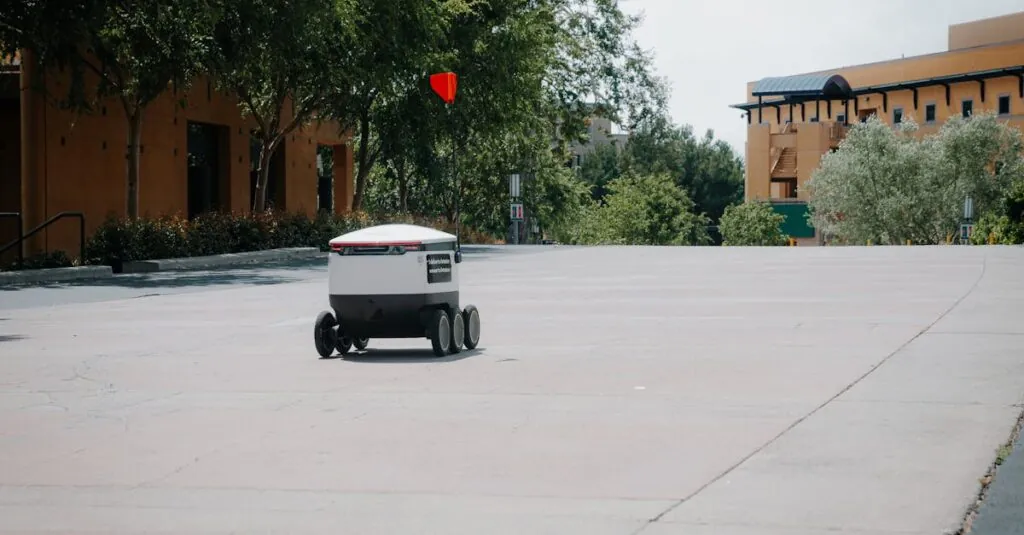Table of Contents
ToggleImagine a world where traffic jams are a thing of the past, and getting from point A to point B feels like a breeze. Enter intelligent transportation systems, or ITS for short. These technological marvels are revolutionizing how people and goods move, making commutes smoother and safer. With real-time data, smart traffic lights, and connected vehicles, ITS is like having a personal traffic wizard guiding the way.
Overview of Intelligent Transportation Systems
Intelligent transportation systems (ITS) enhance urban mobility and safety through advanced technologies. These systems leverage real-time data to optimize traffic management. Smart traffic signals adjust timings based on current traffic conditions to reduce delays. Vehicles equipped with communication technology can share information regarding road conditions and obstacles.
ITS platforms integrate various components, including connected vehicles, traffic cameras, and sensors. Each component plays a crucial role in providing accurate information to users. Real-time updates on traffic congestion, accidents, and weather conditions inform drivers’ decisions. Journey times shorten as a result of improved traffic flow.
Users benefit from applications that offer navigation assistance tailored to current conditions. Enhanced route planning reduces travel delays and minimizes emissions. Ridesharing services utilize ITS to coordinate pickups more effectively, contributing to better overall transportation efficiency.
The role of ITS extends beyond daily commuting. Public transit systems implement ITS for improved schedule adherence and passenger information. Automated systems manage fleet operations, ensuring reliable service to commuters. Safety is prioritized as ITS identifies hazardous situations promptly, maintaining safer environments for pedestrians and drivers.
ITS represents a critical shift in how urban transportation infrastructure operates. Its ability to connect systems and provide data-driven insights revolutionizes travel experiences. Cities adopting ITS experience reduced congestion and increased user satisfaction. Enhanced transportation systems pave the way for smarter, more efficient cities.
Key Components of Intelligent Transportation Systems
Intelligent transportation systems encompass several key components that work together to enhance urban mobility and safety. These elements include traffic management systems and vehicle-to-infrastructure communication, both critical in creating efficient travel experiences.
Traffic Management Systems
Traffic management systems play a vital role in reducing congestion and improving road safety. Smart traffic signals dynamically adjust their timings based on real-time data from sensors and cameras. These signals analyze vehicle flow and pedestrian activity, allowing for optimized traffic flow. Additionally, implementing adaptive traffic control systems responds to changing traffic patterns more effectively. Data-driven insights from traffic management systems enable city planners to make informed decisions that prioritize safety and efficiency. Ultimately, these systems significantly enhance the overall commuting experience.
Vehicle-to-Infrastructure Communication
Vehicle-to-infrastructure communication enhances connectivity between vehicles and the surrounding infrastructure. This technology allows vehicles to exchange information with traffic signals, road signs, and other critical infrastructure. By sharing data about speed limits, upcoming hazards, and traffic patterns, vehicles can adjust their behavior in real-time. Moreover, enhanced communication bolsters safety measures, allowing vehicles to receive alerts about accidents or road closures. This system ultimately promotes smoother traffic flow and minimizes delays. Implementing vehicle-to-infrastructure communication represents a significant step toward fully connected transportation ecosystems.
Benefits of Intelligent Transportation Systems
Intelligent transportation systems (ITS) offer significant advantages for urban mobility and safety. These systems enhance overall travel experiences by implementing advanced technologies.
Enhanced Traffic Safety
Enhanced traffic safety stands out as a primary benefit of ITS. Smart traffic lights respond to real-time data from sensors, reducing the likelihood of accidents. Vehicle-to-infrastructure communication ensures that drivers receive timely warnings about hazards, speed limits, or changes in road conditions. Traffic cameras monitor activities on roads, allowing real-time assessment of any dangerous situations. ITS promotes safer environments by providing immediate feedback to both drivers and city planners. When cities can adjust traffic light timings, the chances of collisions diminish significantly.
Reduced Traffic Congestion
Reduced traffic congestion significantly improves travel efficiency. ITS employs smart traffic signals that adapt to current traffic flow conditions, allowing for smoother transitions at intersections. Data from connected vehicles and sensors provides insights into traffic patterns, enabling timely responses to prevent backup. Ridesharing applications benefit from ITS technology, optimizing routes and reducing the number of vehicles on roads. Public transit systems also experience fewer delays as ITS enhances schedule adherence. By streamlining the movement of vehicles, ITS fosters quicker commutes and minimizes frustration for all road users.
Challenges and Limitations
Intelligent transportation systems face several challenges that affect their implementation and effectiveness. Understanding these limitations helps stakeholders navigate potential issues.
Data Privacy Concerns
Data privacy poses significant challenges for intelligent transportation systems. Collection of real-time data from vehicles and infrastructure raises concerns about personal privacy. Users may worry about the extent to which their location and travel behaviors are monitored. Regulations like the General Data Protection Regulation (GDPR) establish guidelines on handling personal information, compelling ITS developers to implement measures that protect user data. Solutions include anonymizing data and offering clear consent protocols. Balancing data collection with privacy safeguards ensures user trust while allowing cities to optimize traffic management.
Implementation Costs
Implementation costs can present substantial barriers for cities adopting intelligent transportation systems. Budget constraints often limit the ability to invest in advanced technologies. Costs include upgrading infrastructure, purchasing new equipment, and ongoing maintenance. Cities must also account for expenses associated with training personnel to operate these systems effectively. Funding sources like federal grants and public-private partnerships can help alleviate financial burdens. Cities that prioritize cost-effective strategies can harness the benefits of ITS while managing budgets.
Future Trends in Intelligent Transportation Systems
Emerging technologies are set to transform intelligent transportation systems (ITS) significantly. Autonomous vehicles represent a major trend, as they integrate advanced sensors and machine learning algorithms to navigate safely. These vehicles communicate with smart infrastructures, enhancing overall traffic management.
Connected infrastructure plays a crucial role in this evolution. Smart intersections equipped with adaptive signal control adjust timings based on real-time traffic patterns. Such systems minimize delays, optimizing vehicle flow and reducing congestion.
Sustainability trends also shape the future of ITS. Electric and hybrid vehicle integration into transportation networks reduces emissions and promotes greener urban environments. Cities will increasingly focus on creating smart charging stations to support these vehicles, facilitating widespread adoption.
Data analytics and artificial intelligence enable predictive traffic modeling. By analyzing historical data, ITS can forecast traffic patterns, allowing for proactive measures to mitigate congestion. Enhanced algorithms support real-time decision-making and route optimization for commuters.
Collaboration between public and private sectors drives innovation. Partnerships encourage investment in new technologies and services, improving transport efficiency. Ridesharing companies actively leverage ITS data, optimizing fleet operations to align with commuter needs.
Cybersecurity measures have become a top priority. As systems become more connected, protecting data from potential breaches is essential. Cities must implement robust frameworks to safeguard users’ information.
User engagement applications enhance commuting experiences. Real-time information about traffic conditions, public transit schedules, and alternative routes empowers users to make informed travel decisions. These apps cater specifically to individual preferences, improving satisfaction.
The integration of ITS continues to expand into various sectors. Logistics and delivery services utilize ITS data to streamline operations, reducing costs and increasing efficiency. As urban areas grow, ITS advances will play a vital role in shaping sustainable, functional, and efficient transportation systems.
Intelligent transportation systems are revolutionizing urban mobility by leveraging advanced technologies to create safer and more efficient travel experiences. By integrating real-time data and smart infrastructure, ITS not only alleviates congestion but also enhances traffic safety. The ongoing challenges related to data privacy and implementation costs must be addressed to fully realize the potential of these systems.
As cities continue to evolve, the adoption of ITS will be crucial in shaping sustainable transportation solutions. The future promises even greater advancements with the rise of autonomous vehicles and smart infrastructure. Embracing these innovations will ultimately lead to smarter cities where commuting becomes a seamless and enjoyable experience for all.




